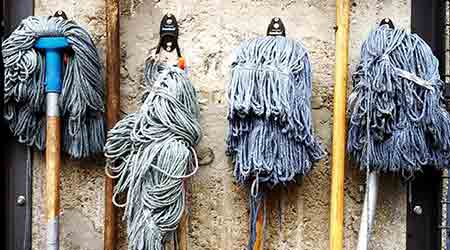
Kaivac, maker of OmniFlex floor cleaning systems, recently launched its "Stop the Mop Campaign," which includes a new website, StoptheMop.com. The campaign and website are designed to educate building managers and the professional cleaning industry how using mops to clean floors can be one of the most unhygienic ways to maintain these surfaces.
Accordingly, the company has put together the following list of the top seven reasons why mops - string, sponge, or microfiber - should not be used to clean floors. In no specific order, here are those critical reasons:
1. A new microfiber mop removes only about 50 percent of surface bacteria. (American Society of Microbiology, 1971)
2. Mops are actually responsible for bacterial contamination on floors. (Study conducted by Canada's University of Ottawa)
3. "Mops can be a serious potential source of [floor] contamination...even when soaked in disinfectant overnight, contaminants could still be detected." (The Pharmaceutical Journal, March 18, 2000)
4. Public restrooms are usually mopped. The "germiest" place in a public restroom is the floor, with about two million bacteria per square inch. (Columbia University; ABC News Investigative Report, October 2011)
5. Within a week, a mop can grow a bacterial population of millions. How often have you reused a mop that has soaked in a bucket?
6. "Mops should not be used for routine cleaning." (University of Maryland, 2007)
7. "Mops stored wet supported bacterial growth to very high levels and could not be adequately decontaminated by chemical disinfection." (Reported in Food Safety and Quality, February 2015)
"And, there are many other setbacks and issues that cleaning professionals should know about using mops to clean floors, including that it is a cumbersome, time-consuming process," adds Matt Morrison, communications manager for Kaivac. "Mopping is slow, stressful, fatiguing, and, as we know, just does not work all that well."

 The Down and Dirty on Cleaning in Virus Season
The Down and Dirty on Cleaning in Virus Season How Surfactant Use is Expanding in Commercial Cleaning
How Surfactant Use is Expanding in Commercial Cleaning Operational Excellence Series 2025: Better Budgeting
Operational Excellence Series 2025: Better Budgeting